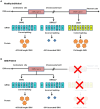Diving into progress: a review on current therapeutic advancements in spinal muscular atrophy
- PMID: 38854961
- PMCID: PMC11157111
- DOI: 10.3389/fneur.2024.1368658
Diving into progress: a review on current therapeutic advancements in spinal muscular atrophy
Abstract
Spinal muscular atrophy (SMA) is an uncommon disorder associated with genes characterized by the gradual weakening and deterioration of muscles, often leading to substantial disability and premature mortality. Over the past decade, remarkable strides have been made in the field of SMA therapeutics, revolutionizing the landscape of patient care. One pivotal advancement is the development of gene-targeted therapies, such as nusinersen, onasemnogene abeparvovec and risdiplam which have demonstrated unprecedented efficacy in slowing disease progression. These therapies aim to address the root cause of SMA by targeting the survival motor neuron (SMN) gene, effectively restoring deficient SMN protein levels. The advent of these innovative approaches has transformed the prognosis for many SMA patients, offering a glimmer of hope where there was once limited therapeutic recourse. Furthermore, the emergence of small molecule compounds and RNA-targeting strategies has expanded the therapeutic arsenal against SMA. These novel interventions exhibit diverse mechanisms of action, including SMN protein stabilization and modulation of RNA splicing, showcasing the multifaceted nature of SMA treatment research. Collective efforts of pharmaceutical industries, research centers, and patient advocacy groups have played an important role in expediting the translation of scientific discoveries into visible clinical benefits. This review not only highlights the remarkable progress achieved in SMA therapeutics but also generates the ray of hope for the ongoing efforts required to enhance accessibility, optimize treatment strategies, rehabilitation (care and therapies) and ultimately pave the way for an improved quality of life for individuals affected by SMA.
Keywords: nusinersen; onasemnogene abeparvovec; rehabilitation; risdiplam; spinal muscular atrophy; survival motor neuron.
Copyright © 2024 Bagga, Singh, Ram, Kapil and Singh.
Conflict of interest statement
The authors declare that the research was conducted in the absence of any commercial or financial relationships that could be construed as a potential conflict of interest.
Figures



Similar articles
-
Health Care Resource Utilization and Costs for Patients with Spinal Muscular Atrophy: Findings from a Retrospective US Claims Database Analysis.Adv Ther. 2023 Oct;40(10):4589-4605. doi: 10.1007/s12325-023-02621-y. Epub 2023 Aug 16. Adv Ther. 2023. PMID: 37587305 Free PMC article.
-
[Risdiplam for the treatment of spinal muscular atrophy].Zh Nevrol Psikhiatr Im S S Korsakova. 2024;124(2):45-57. doi: 10.17116/jnevro202412402145. Zh Nevrol Psikhiatr Im S S Korsakova. 2024. PMID: 38465810 Russian.
-
Gene Therapy for Spinal Muscular Atrophy (SMA): A Review of Current Challenges and Safety Considerations for Onasemnogene Abeparvovec (Zolgensma).Cureus. 2023 Mar 15;15(3):e36197. doi: 10.7759/cureus.36197. eCollection 2023 Mar. Cureus. 2023. PMID: 37065340 Free PMC article. Review.
-
Nusinersen: A Review in 5q Spinal Muscular Atrophy.CNS Drugs. 2021 Dec;35(12):1317-1328. doi: 10.1007/s40263-021-00878-x. Epub 2021 Nov 30. CNS Drugs. 2021. PMID: 34850360 Free PMC article.
-
Onasemnogene Abeparvovec: A Review in Spinal Muscular Atrophy.CNS Drugs. 2022 Sep;36(9):995-1005. doi: 10.1007/s40263-022-00941-1. Epub 2022 Aug 12. CNS Drugs. 2022. PMID: 35960489 Review.
Cited by
-
Ubiquitination Insight from Spinal Muscular Atrophy-From Pathogenesis to Therapy: A Muscle Perspective.Int J Mol Sci. 2024 Aug 13;25(16):8800. doi: 10.3390/ijms25168800. Int J Mol Sci. 2024. PMID: 39201486 Free PMC article. Review.
-
Spinal muscular atrophy carrier screening program: awareness and attitude of healthcare professionals in Turkey.J Community Genet. 2024 Dec;15(6):665-672. doi: 10.1007/s12687-024-00737-4. Epub 2024 Oct 11. J Community Genet. 2024. PMID: 39392569 Free PMC article.
-
Compound Heterozygous RYR1 Variants in a Patient with Severe Congenital Myopathy: Case Report and Comparison with Additional Cases of Recessive RYR1-Related Myopathy.Int J Mol Sci. 2024 Oct 9;25(19):10867. doi: 10.3390/ijms251910867. Int J Mol Sci. 2024. PMID: 39409197 Free PMC article.
-
The Socio-Economic Burden of Spinal Muscular Atrophy: A Cost-of-Illness Study in Bulgaria.Healthcare (Basel). 2025 Feb 13;13(4):401. doi: 10.3390/healthcare13040401. Healthcare (Basel). 2025. PMID: 39997276 Free PMC article.
References
-
- Willis TA. Therapeutic advances in spinal muscular atrophy. Paediatr Child Health. (2023) 33:23–8. doi: 10.1016/j.paed.2022.12.010 - DOI
Publication types
LinkOut - more resources
Full Text Sources
Miscellaneous

